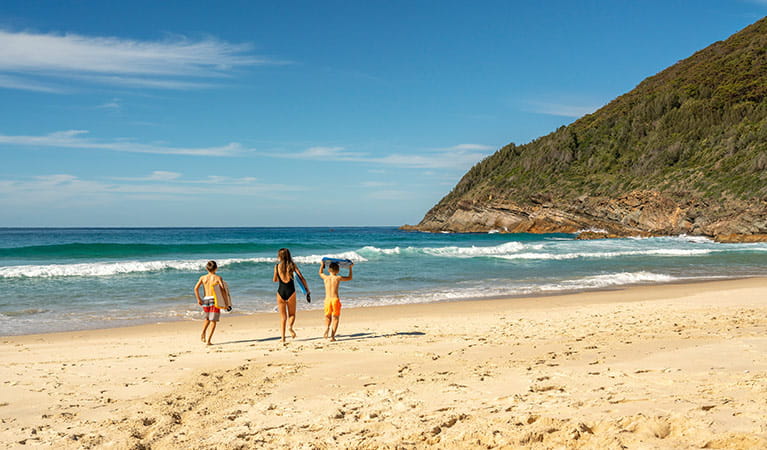Booti Booti National Park
Overview
Booti Booti National Park sits on an 8km peninsula between the Pacific Ocean and beautiful Wallis Lake, near Forster. Explore the beaches, walking tracks, lookouts, and coastal rainforest on a day trip or camp overnight.
Read more about Booti Booti National Park
Scenically located between the coast and a tranquil lake, on the NSW mid-north coast, Booti Booti National Park takes in scenic headlands, beautiful beaches, refreshing rainforest, and 11km of estuarine foreshore. The name comes from “butibuti,” the local Worimi Aboriginal word meaning “plenty of honey.”
Plenty is certainly a common theme here – plenty of hiking, swimming, birdwatching, and whale watching in the winter as they migrate along the coast. There are plenty of opportunities to settle down in a picnic spot beneath the paperbarks, and plenty of surfing and mountain biking for the young at heart.
The beaches are an enduring favourite, with families and sun-lovers turning weekends into energetic gatherings. Add in terrific driving tours and some truly stunning lookouts like the one at Cape Hawke, and you have a park that appeals across the board. Booti Booti has plenty for everyone.
Local alerts
For the latest updates on fires, closures and other alerts in this area, see https://www.nationalparks.nsw.gov.au/visit-a-park/parks/booti-booti-national-park/local-alerts
Contact
- in the North Coast region
Booti Booti National Park is always open but may have to close at times due to poor weather or fire danger.
-
Park entry fees:
$8 per vehicle per day. Day passes are available from the Manning Great Lakes Area Office, Bulahdelah Visitor Information Centre and the Hawks Nest Newsagency.
Buy annual pass. -
-
Booti Booti Office
02 6591 0300
Contact hours: Monday to Friday, 8.30am to 4.30pm. Closed public holidays. - The Ruins campground, Booti Booti National Park, 4374 The Lakes Way, Booti Booti 2428
-
Email: npws.manninggreatlakes@environment.nsw.gov.au
-
Booti Booti Office
Visitor info
All the practical information you need to know about Booti Booti National Park.
Map
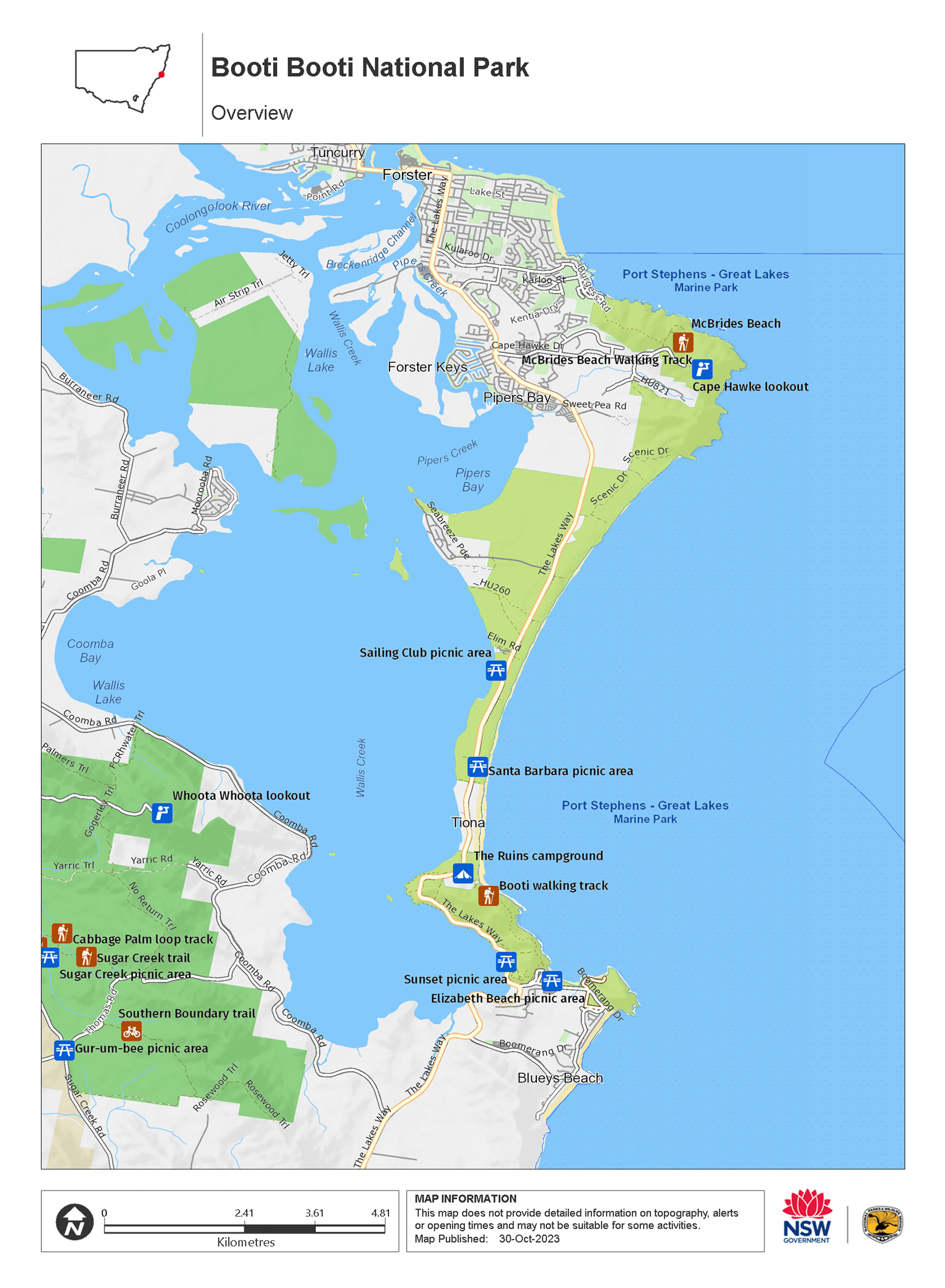
Map legend

Getting there and parking
Get driving directions
From Forster:
- Head south along the Lakes Way
- It’s 20km to Ruins campground and the Great Lakes Park Office
From Newcastle:
- Head north on the Pacific Highway
- Just past Bulahdelah, turn right onto The Lakes Way (signposted ‘Seal Rocks’).
- Follow The Lakes Way for approximately 55km to Pacific Palms
- Continue along The Lakes Way until you see Ruins campground and the Great Lakes Park Office on your right
Parking Show more
- Cape Hawke lookout See on map
- Elizabeth Beach picnic area See on map
- Sailing Club picnic area See on map
- Santa Barbara picnic area See on map
- The Ruins campground and picnic area See on map
By bike
Check out the Bicycle information for NSW website for more information.
By public transport
A bus from Sydney or Newcastle to Forster can be stopped at the Ruins campground by asking the driver. Call Busways on 1800 043 263.
For further information about public transport options, visit the NSW country transport info website
Best times to visit
Autumn
The crisp sunny days of autumn are perfect for packing up a picnic or barbecue hamper and heading out for a day relaxing in the sun.
Spring
Magnificent wildflower displays as they bloom across the heathlands.
Summer
Swim at the seasonally patrolled Elizabeth Beach or kayak in Wallis Lake, whilst staying at the nearby Ruins campground.
Winter
Visit Cape Hawke lookout to watch whales migrating off the coast.
Weather, temperature and rainfall
Summer temperature
Average
15°C and 30°C
Highest recorded
45.2°C
Winter temperature
Average
5°C and 20°C
Lowest recorded
-5°C
Rainfall
Wettest month
March
Driest month
September
The area’s highest recorded rainfall in one day
280.2mm
Facilities
Toilets
- Elizabeth Beach picnic area
- Sailing Club picnic area
- Santa Barbara picnic area
- The Ruins campground and picnic area
Picnic tables
- Elizabeth Beach picnic area
- Sailing Club picnic area
- Santa Barbara picnic area
- The Ruins campground and picnic area
Barbecue facilities
Boat ramp
Drinking water
Showers
Maps and downloads
Fees and passes
Park entry fees:
$8 per vehicle per day. Day passes are available from the Manning Great Lakes Area Office, Bulahdelah Visitor Information Centre and the Hawks Nest Newsagency.
- All Parks Pass - For all parks in NSW (including Kosciuszko NP) $190 (1 year) / $335 (2 years)
- Multi Parks Pass - For all parks in NSW (except Kosciuszko) $65 (1 year) / $115 (2 years)
- Country Parks Pass - For all parks in Country NSW (except Kosciuszko) $45 (1 year) / $75 (2 years)
- Single Country Park Pass - For entry to a single park in country NSW (except Kosciuszko). $22 (1 year) / $40 (2 years)
Annual passes and entry fees (https://www.nationalparks.nsw.gov.au/passes-and-fees)
Prohibited
Generators
Generators are prohibited in this park.
Pets
Pets and domestic animals (other than certified assistance animals) are not permitted. Find out which regional parks allow dog walking and see the pets in parks policy for more information.
Smoking
NSW national parks are no smoking areas.
Nearby towns
Forster (8 km)
Dominated by water sports Forster is the centre of the Great Lakes area.
Taree (43 km)
Taree is a major mid North Coast city, ringed by superb beaches. It's situated on the Manning River and set against rolling hills.
Old Bar (50 km)
As well as its beachside attractions, Old Bar is an ideal base for exploring nearby natural attractions. Crowdy Head National Park and the beautiful waterways of Myall lakes National Park are just two of the best.
Learn more
Booti Booti National Park is a special place. Here are just some of the reasons why:
Spirituality, identity and lifestyle
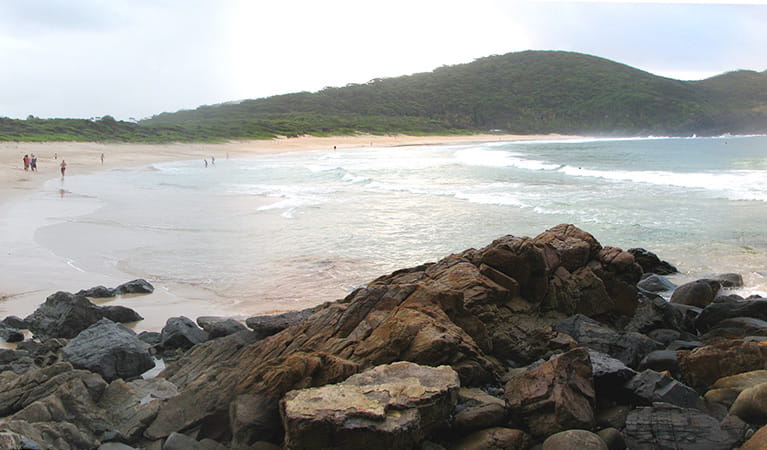
Booti Booti National Park holds important cultural significance for the Worimi Aboriginal people, who have lived on and used the land and waters for many thousands of years. Dozens of Aboringal sites exist within the park, including artefact scatters, stone quarries, tool sites, and shell middens. These are important markers of Aboriginal history in the region, demonstrating how land, water, plants and animals contributed to and continue to have significance for Aboriginal identity, spirituality, and lifestyle.
- Aboriginal culture Bring your students to this unique excursion in Booti Booti National Park, near Forster. They’ll experience the park through the eyes of an Aboriginal person on this Stage 2 (Years 3-4) Aboriginal culture Geography excursion.
- Junior ranger: Booti Booti coastal adventure tour Join us for a Junior ranger adventure, as we traverse the shores of Seven Mile Beach. Walk alongside a Discovery Ranger to find out what plants and animals live here, and how they survive in this magical environment.
Aye, Captain
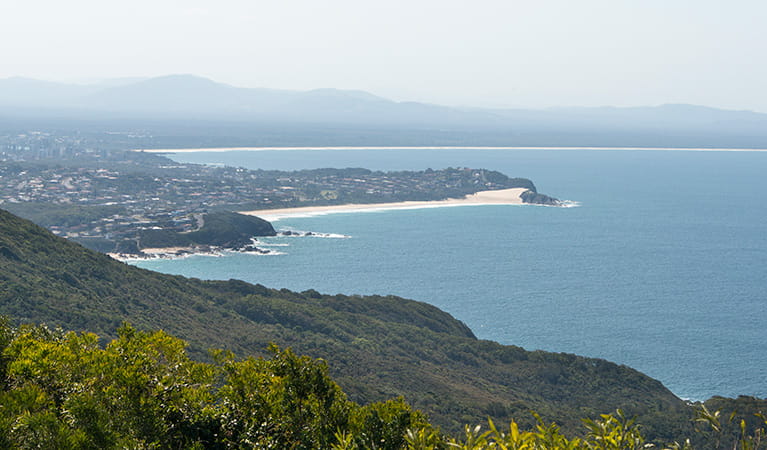
Captain Cook first sighted Cape Hawke on May 12, 1770, and named it in honour of the First Lord of the Admiralty, Edward Hawke. The famous explorer and surveyor John Oxley later passed through the area in 1818. The first European inhabitant was Captain J. Gogerly, who sailed between Forster and Sydney ferrying timber, oyster shells, and sandstone. Today you can pay respects to Captain Gogerly and some of his relatives at their gravemarkers, across the road from the Ruins campground.
- Booti walking track Just 20km from Forster, Booti walking track is a loop walk which beautifully captures the park's scenic features and offers family-friendly opportunities for swimming and picnicking.
- Junior ranger: Booti Booti coastal adventure tour Join us for a Junior ranger adventure, as we traverse the shores of Seven Mile Beach. Walk alongside a Discovery Ranger to find out what plants and animals live here, and how they survive in this magical environment.
A haven for birds and birdwatchers alike
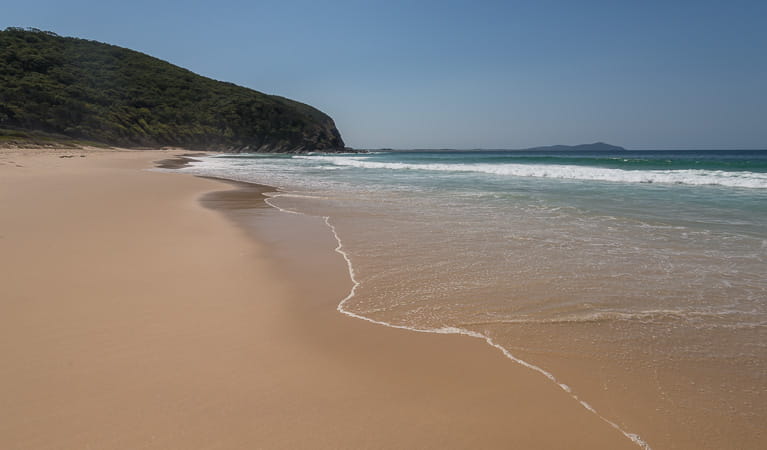
Booti Booti National Park features a substantial number of amphibians and reptiles, including red-bellied black snakes, brown snakes, rose-crowned snakes and blue-bellied swamp snakes. Goannas are regular visitors to The Ruins campground and picnic areas, and you may even be lucky enough to see a land mullet or water dragon. The unusual peninsula between the Pacific Ocean and Wallis Lake also provides an outstanding habitat for over 210 species of birds, including rainbow and scaly-breasted lorikeets, yellow-faced honeyeaters and silvereyes, as well as a number of waterbirds, including pelicans and the endangered little tern.
- Cape Hawke lookout Just five minutes from Forster, the Cape Hawke lookout offers spectacular views along the coast from the top of a dedicated tower, perfect for whale watching.
- Elizabeth Beach picnic area A short drive from Forster, Elizabeth Beach picnic area offers a great spot to relax near a beach popular for swimming in summer and whale watching in winter.
- Junior ranger: Booti Booti coastal adventure tour Join us for a Junior ranger adventure, as we traverse the shores of Seven Mile Beach. Walk alongside a Discovery Ranger to find out what plants and animals live here, and how they survive in this magical environment.
- Sailing Club picnic area An alternative to the ocean-front options of Booti Booti National Park, Sailing Club picnic area offers a shady rest spot on the shore of Wallis Lake.
Plants and animals protected in this park
Animals
-
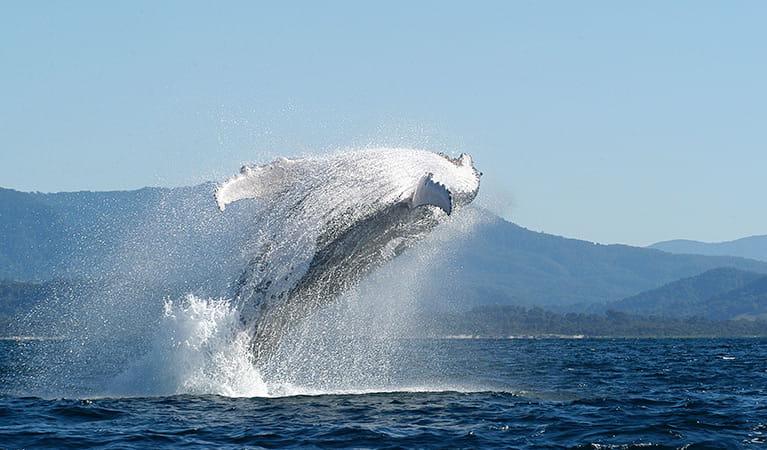
Humpback whale (Megaptera novaeangliae)
The humpback whale has the longest migratory path of any mammal, travelling over 5000km from its summer feeding grounds in Antarctica to its breeding grounds in the subtropics. Its playful antics, such as body-rolling, breaching and pectoral slapping, are a spectacular sight for whale watchers in NSW national parks.
-
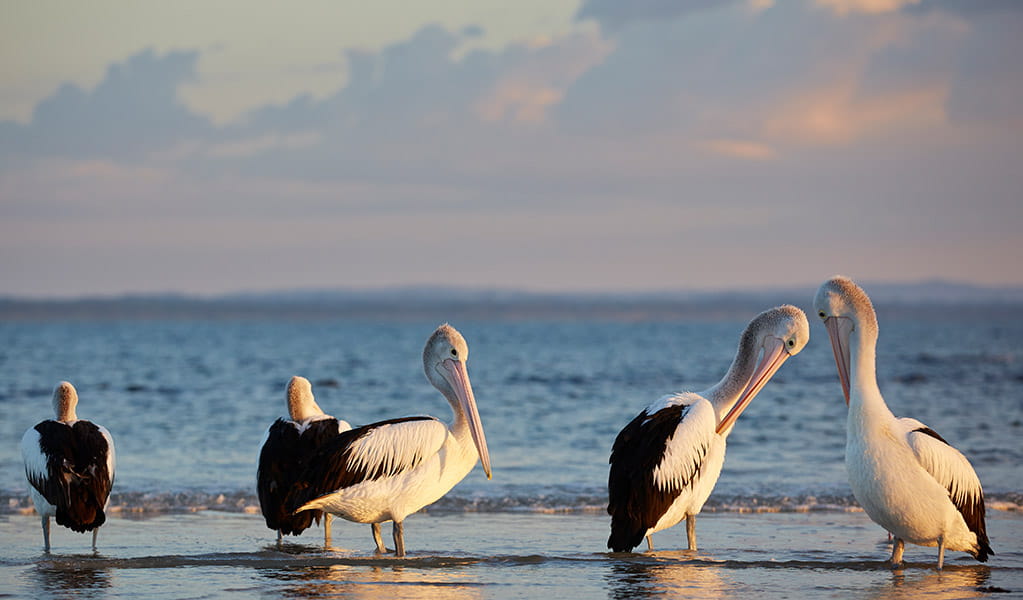
Australian pelican (Pelecanus conspicillatus)
The curious pelican is Australia’s largest flying bird and has the longest bill of any bird in the world. These Australian birds are found throughout Australian waterways and the pelican uses its throat pouch to trawl for fish. Pelicans breed all year round, congregating in large colonies on secluded beaches and islands.
-
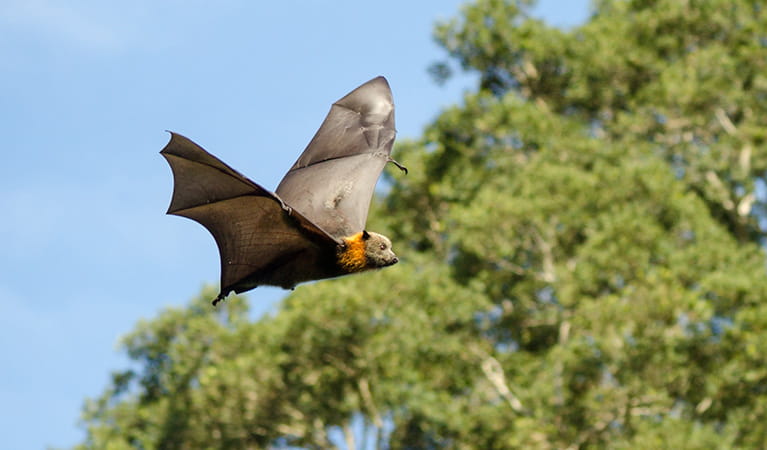
Grey-headed flying-fox (Pteropus poliocephalus)
The grey-headed flying fox is Australia's largest native bat, with a wingspan up to 1m. This threatened species travels up and down south-eastern Australia and plays a vital role in pollinating plants and spreading seeds in our native forests.
-
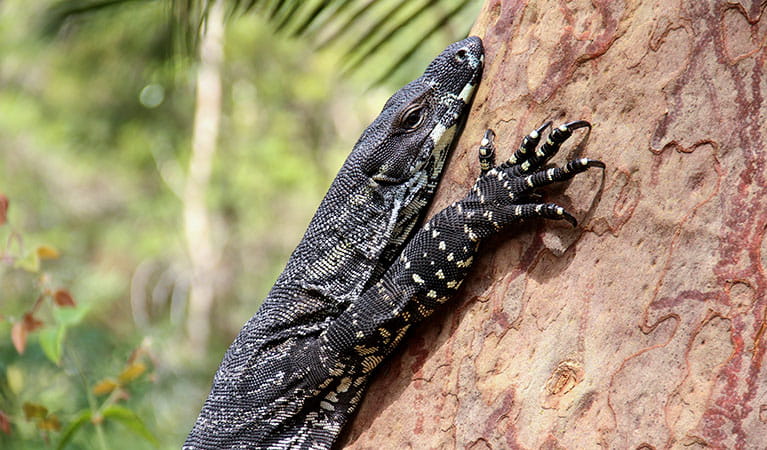
Lace monitor (Varanus varius)
One of Australia’s largest lizards, the carnivorous tree-dwelling lace monitor, or tree goanna, can grow to 2m in length and is found in forests and coastal tablelands across eastern Australia. These Australian animals are typically dark blue in colour with whitish spots or blotches.
-
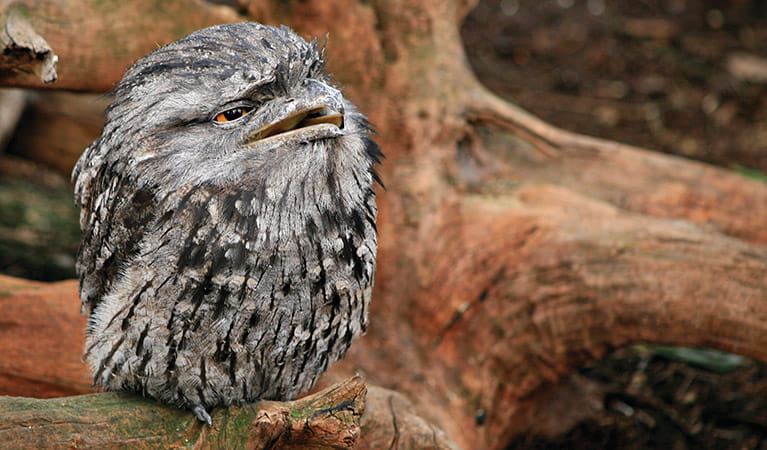
Tawny frogmouth (Podargus strigoides)
Found throughout Australia, the tawny frogmouth is often mistaken for an owl due to its wide, powerful beak, large head and nocturnal hunting habits. The ‘oom oom oom’ call of this native bird can be heard echoing throughout a range of habitats including heath, woodlands and urban areas.
Education resources (1)
School excursions (4)
- Global environments - rainforest magic, Stage 4 (Years 7-8), Geography
- Aboriginal culture, Stage 2 (Years 3-4), Geography
- Exploring the rainforest, Stage 2 (Years 3-4), Geography
- The earth's environment, Stage 2 (Years 3-4), Geography
What we're doing
Booti Booti National Park has management strategies in place to protect and conserve the values of this park. Visit the OEH website for detailed park and fire management documents.
Managing weeds, pest animals and other threats
Pests and weeds have a significant impact to the ecosystems and habitats within Booti Booti National Park. Pest reduction of wild dogs is an important part of the work NPWS does to protect the integrity of biodiversity within this park.

